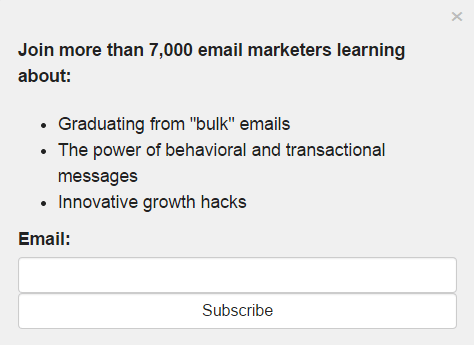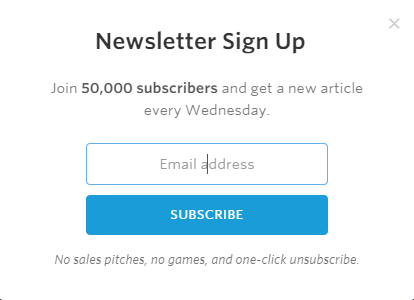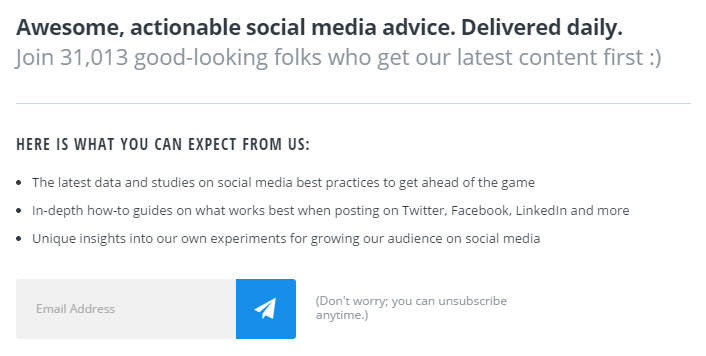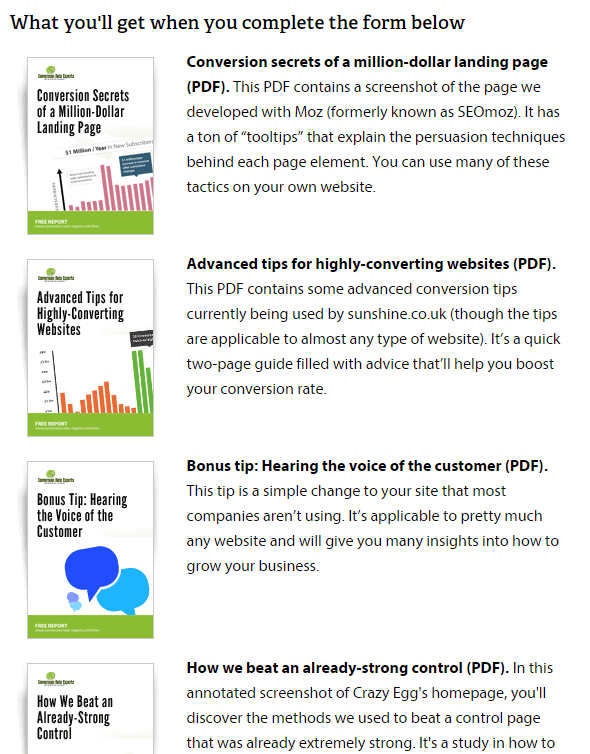You know how hard it is to pull yourself away from watching an addictive TV show. And you know how harmless it seems to watch “just one more episode” on Netflix, but then it turns out not to be just one.
What is it about those shows that make them so addictive?
More importantly, how can you apply it to writing email opt-in copy that literally gets people hooked the second they read it?
First, let’s understand what Hollywood knows that we don’t.
They know that people are pressed for time now more than ever and that they have more responsibilities than they can handle. So, why even believe that anyone would sit down for an hour … let alone several hours … to watch a TV show?
Well, for one thing, Hollywood also knows that people are dying for an escape. They don’t want to think about their day and all their responsibilities.
And, Hollywood knows something else.
They know that if they don’t capture someone’s attention within the first couple of seconds of a show, they’ve lost them. As all of you marketers reading this know, if you don’t grab people’s attention with your copy within the first few seconds, you’ve lost them, too. Worse, you haven’t just lost a viewer, you’ve lost a sale and a potential lifelong customer relationship.
So what is the technique that Hollywood uses to keep people around?
Aside from having a great story, they use a proven psychological principle called “open loops.”
In psychologist Maria Konnikova’s book, Mastermind: How to Think Like Sherlock Holmes, she talks about how not having closure on something actually produces anxiety in people, which is why we feel a compulsion to tie up loose ends.
Open loops in TV shows are the equivalent of that cliffhanger that keeps you up at night, consuming your mind with thinking about what’s going to happen the next week, or that storyline that was never quite explained. Those aren’t just “blips” in a script. They are placed there so that it’s harder for people to get up off the couch than it is to stay and watch “just one more episode.”
Now here’s the million dollar question for you: What if your copy was that powerful?
What if it was harder for people to close the window and never visit your website again than to stay and give you their email address?
Daniel Goleman, the best-selling author of Emotional Intelligence, has researched extensively what it takes to motivate and inspire people. He has proven that in order to make people want to take action, you must sway their emotions. But if you can’t talk to someone one-on-one, the next best way to be emotionally compelling is with your words, or in our case, copy.
If you plan on competing for people’s email addresses (which most of you are), you need to know the right words to use so that when someone comes to your site, you’ve created such a compelling solution to their problem that their brain practically forces them to relieve the pain of not knowing how you can help them.
But how?
I’m going to show you examples of what three companies are doing wrong and exactly how they can tweak their copy with words that will make their offer irresistible to anyone who sees it. These tweaks are straightforward and simple, and any marketer can apply them to their own business.
1. Get Vero’s opt-in copy
Now, when you first look at Get Vero’s opt-in copy, it seems pretty good, right? They’re specific with their numbers, and the material seems interesting. But, what’s wrong?
- Look at the language in the first line. When you first read it, as a marketer, are you really interested in “learning” more? You probably get hundreds of emails a day. The question people have is what they are going to “get” from giving you their email address. People are naturally self-centered, and you can use that to your advantage.
- Graduating from “bulk” emails may be something Get Vero’s market is interested in, but the more important question to ask is why? What does graduating from bulk emails help a marketer do?
- The second bullet talks about the power of behavioral and transactional messages. I’m sure we all can agree that sounds great, but again, why? What will it help us do? Increase engagement? Sales? Why should we bother improving our messages?
- And the last bullet “innovative growth hacks” is copy that anyone could use. The question here is what’s different about what Get Vero is doing than anyone else? Why should I sign up for their growth hacks vs. someone else’s growth hacks?
So how would you go about rewriting this?
First, understand what it is that your audience is coming to your site for. What do they really need help with? You can even use the words they’ve given you in surveys, comments, or conversations.
Second, remember the open loop technique so you instantly leave people’s mouths watering for more. The simple formula is this:
Tell people what “it” is — a technique, a secret, a tip, a trick, or a guide — and then tell them exactly what it will do for them! So, if I were to rewrite their copy, it might look like this:
Join our list of 7,000 marketers to:
- Graduate from “bulk” emails so customers can get your messages 10x faster
- Get examples of emails that pulled in millions, and learn how to make your emails instantly hook people for life
- Use our 3 simple hacks that could double or triple your business in the next month!
Even though I’m not familiar with Get Vero’s audience, isn’t this copy much more attractive? Not only is it much more specific so you can visualize exactly what you’ll get, but the possibilities of what it will do for you piques so much curiosity that you HAVE to find out what those emails look like and what those hacks are.
2. Help Scout’s opt-in copy
Here is where it gets interesting. Even if a company has thousands of subscribers, sometimes one of their main goals is to grow that list because that’s where they get most of their revenue. I’m always surprised when I see opt-in copy that doesn’t truly help the person who’s visiting.
The problem here is not with Help Scout’s content. Their articles are great. The problem is that just because their articles are good, it doesn’t mean I’m going to give them my email address and add even more “stuff” to my inbox. (No matter how great your company is, you still need to work to get the trust of your existing customers and potential customers.)
With this opt-in copy, I would specifically think about what Help Scout can give that no other company in their space can. What has 100% to do with the problems their audience consistently faces? They can create a compelling guide for teams that use their service, or they can even talk about the value of their articles if they don’t have anything tangible to give.
The idea is to not just say “one article a week.” No one wants another article. Remember the simple formula:
Tell them what it is … and what it will do for them!
So, if I were to rewrite the copy, I’d think about what Help Scout’s audience is interested in and even combine their 5 best articles as a guide:
Sign Up for Your Free Guide: How to Keep Your Customers for Life
- The little-known secret Walt Disney used to create magical experiences for customers, and how you can do it online
- The real reason slower service beats fast service, and a script you can have your team use to turn a dissatisfied customer into a happy one
- 6 easy ways to get customers to stay with you long after the sale so they’re delighted to buy from you over and over
The reason this is much more compelling than “Join 50,000 subscribers for an article” is because of what the open loop starts doing to the visitor’s brain: “Hmm … What’s the secret? Should I be paying more attention to the quality and speed of my service? 6 ways to keep the same customers after the sale? Wait … Maybe there’s something I don’t know! I need to find out.” If Help Scout tweaked that one thing, they could reasonably double their opt-in rate.
3. Buffer’s opt-in copy
Here’s where it gets tricky. Because at first glance, this looks good. It looks specific. It’s cheeky. What more could you want from opt-in copy? Well, more opt-ins!
Let’s take a look at what’s going on here:
- It’s great that they have 31,013 people on their list, but are people really pulled by getting their content first? People don’t just value content. They value what the content itself can do for them.
- Now, their first bullet is pretty good, but “getting ahead of the game” is generic. What does their audience actually want to do with social media, specifically? Know when to post so they get more leads and engagement? Know when to use it to launch a product? What is the actual “game” they’re interested in?
- The second bullet is almost a repetition of the first, but again, people don’t want to know only what works best to “post.” Why do they want to know that information? What’s in it for them?
- The last one is also similar to the first and second bullets. People need to be told why seeing your experiments will be helpful for them, especially if they’re at a different stage. Is it growing their audience from 0-1,000? Is it growing it to 10,000? What is it that they really want to know how to do?
The simple formula bears repeating: Tell them what it is … and what it will do for them!
If I were tasked with rewriting this, here’s how I’d use the open loop technique to make Buffer’s offer irresistible:
Just 1 Email from Us Can Explode Your Social Media Game
We’re going to send you 1 email a day. You’re going to take action and get results like this:
- 1,000 new followers in just a month, using our “1-2 Punch” technique
- Turn your fans into raving customers, using our in-depth guide on posting to Twitter, Facebook, and LinkedIn
- Tripling and quadrupling your audience with VIP access to our secret experiments and test results from the past 5 years of explosively growing our business
This is the open loop at its best. Of course, Buffer knows their audience better than I do, but this is how you make people drool. “1,000 new followers? What is that technique? Real advice about using social media to get customers? Growing faster than I ever thought by getting behind-the-scenes access to Buffer’s experiments? Shut up and take my email!”
Conclusion and what to do today
Opt-in copy is not the place to be generic or vague. It’s one of the best opportunities you have to captivate your audience and offer them something so compelling that it’s harder for them to close the window than it is to stay. As a marketer, it’s your job to paint the picture and show them what your content, your articles, and your guides can do for them, not just what it is.
As an example of what one company is doing right, just look at what Conversion Rate Experts does to get people to opt-in.
Even if you aren’t interested in working with them, don’t you want to know the conversion secrets of a million dollar landing page? Don’t you want to learn a few tips from high-converting websites? And aren’t you interested in how to beat a control that’s already strong?
Of course! That copy is so detailed and compelling it’s hard for someone who’s not even interested in conversion to look away. This is the kind of copy that shows that you know what’s going to make people sit on the edge of their seat and watch “just one more episode” because they can’t stand not knowing what the answer is.
The best thing for you to do today is to give your opt-in copy an honest assessment (look at your split tests!) and see if it’s actually what your customers are looking for. Then, take what you learn from them and plug in what you’ll give them and exactly what it will do for them. And, of course, keep testing — because you don’t know what works until you see the actual numbers.
Remember this: People actually want to say yes to you because it’s so much easier than saying no. Give them a reason to stay. (Tweet that!)
About the Author: Felicia Spahr is an elite communication coach and author of the book, Selling for Success. On her blog, she writes about communication, power, leadership, sales, persuasion, and charisma. She’s been featured in The Huffington Post, I Will Teach You To Be Rich, Entrepreneur on Fire, The Lifestyle Architect, mindbodygreen, Under30CEO, Elephant Journal, and many more.




Comments (9)